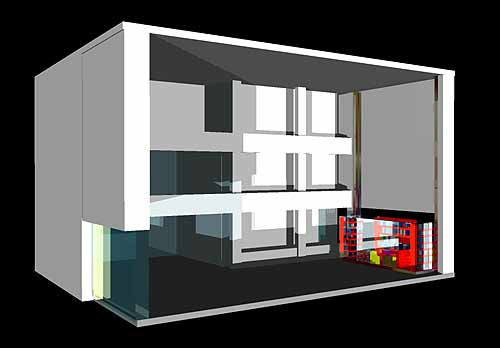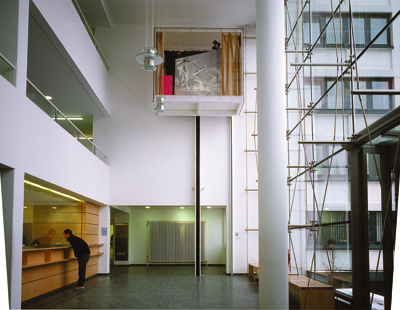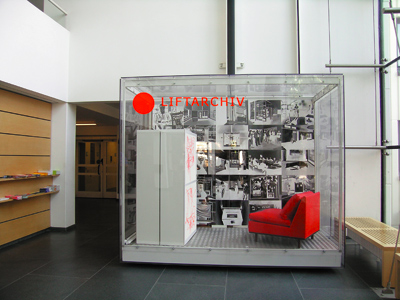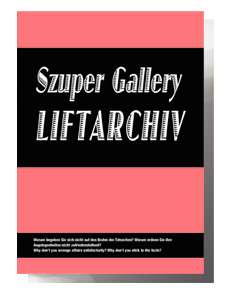



The Object
Glass elevator cabin 2,9 x 1,5 x 2,4 m
Elevator construction extendable to the height of 9 m
Changing installations
The Liftarchiv is a mobile, performative object made for the Kreisverwaltungsreferat (KVR), the district authority. Szuper Gallery has mounted a glass cube onto a lift in the foyer of the KVR, which functions as an archive for the project. A series of events accompanies this sculpture and the archive is continuously being added to. The Liftarchiv aims for a public dialogue. The cube catches the transparency of the glazed foyer and makes it possible for the archive to be seen not only from the foyer but also from the street. When the archive is raised the viewer is denied access. In its raised position the space can not be entered. It becomes the showcase for the archive but functions like a three-dimensional picture of a room. After the active project phase the Liftarchiv with its contents will remain. All materials that were produced over the project period and in relation to the Liftarchiv, including photographs, objects and documents are archived in a permanent installation.
The Place
Kreisverwaltungsreferat (KVR) München
Ruppertstr. 19, Foyer Lindwurmstraße
The KVR is the city and district authority. It is responsible for security and order, for commerce, for citizenship matters (e.g., naturalization, citizenship, passports, residence permits, asylum issues), traffic matters (e.g., traffic surveillance, automobile registration) and fire and catastrophe safety.) The renovation of the 70s building, by the architects Grill + Köppel and R. Dörnfeld, responded to a general brief that aimed at making the institution more open and transparent.
Liftarchiv
Heinz Schütz
Government offices put laws and political decisions into practice.Thus the citizen encounters in government offices the state in its practical manifestation. Public discussion of the
political consequences of the work done by government offices takes place, if at all, in parliament and in the media.
Against this backdrop, one cannot praise enough the decision to open a space for reflection in the local authority in Munich.The Liftarchiv that the artists’ group Szuper Gallery installed in the entrance hall refers to the site of its installation, and in ever new attempts using the means of art, it poses questions about the composition of public space. Unlike most of the works financed from the Kunst-am-Bau budget [a programme to put works of art in public buildings – Trans.], which are typically static, the Liftarchiv, in which one could ride up and down as in an elevator, served as a site for changing exhibitions, installations and videopresentations.
Over the course of four years, Szuper Gallery not only presented its own works but also invited other artists.The spectrum of presentations ranged from a video shot in the corridors of the local authority by way of documenting the history of the micro state Sealand, as a utopia of an autonomous state, in a series of videos that dealt with various aspects of public space – not least repressive ones – by way of the invitation sent by the artists’group schleuser.net and its question DoWe Really Need a New Anti-Imperialism? on to the provocative transformation of the flags ofWestern countries into “burka spectres” or the call to vote on a painting. As befits a democratic discussion, the contributions were controversial.The controversies led to protests and the covering up of the Liftarchiv. Szuper Gallery declared that this temporary covering up was itself part of the artistic discourse. Now that the exhibition phase is complete, the activities will be documented and archived as a permanent installation in the Liftarchiv.
Gläserne Liftkabine 2,9 x 1,5 x 2,4 m
Aufzugskontruktion fahrbar bis Höhe 9 m
Wechselnde Installationen und Bestückung
Das Liftarchiv ist ein bewegliches, bespielbares Objekt, konzipiert für das Kreisverwaltungsreferat der Stadt München (KVR). Der von Szuper Gallery auf einen Lift montierte Glaskubus in der Eingangshalle des KVR wird als Archiv immer wieder neu bestückt und von Veranstaltungen begleitet und sucht dabei den öffentlichen Dialog. Er greift die Transparenz der gläsernen Halle auf, so dass das Archiv nicht nur von innen, sondern auch von der Straße aus einsehbar ist. Wenn das Archiv nach oben gefahren wird, handelt es sich um einen nicht betretbaren Raum. Im hochgefahrenen Zustand dient der Raum als Schaufenster des Archivs, funktioniert aber in diesem Zustand wie das dreidimensionale Bild eines Raumes. Nach Ablauf der aktiven Projektphase bleibt das Liftarchiv samt Archivinhalt bestehen. In einer dauerhaften Installation wird das gesamte, im Projektzeit-raum und im Zusammenhang mit dem Liftarchiv enstandene Material, darunter Fotos, Videos, Objekte und Dokumente, archiviert.
Der Ort
Kreisverwaltungsreferat (KVR) München
Ruppertstr. 19, Foyer Lindwurmstraße
Das KVR ist als städtische Innenbehörde u.a. für Deutsche als Bürgerbüro für Pass- und Personalwesen und für Nichtdeutsche für Fragen des Aufenthalts- und Asylrechts zuständig. Im Rahmen einer allgemeinen Renovierungsmaßnahme wurde das Foyer des in den 1970er Jahren errichteten Amtes von den Architekten Grill + Köppel und R. Dörnfeld ausgebaut. Eine große Glasfassade wurde eingezogen, um die Halle offener und lichter zu gestalten, was auch dem sich wandelnden Image der Behörde entsprechen sollte. Im Gebäude befinden sich Bürgerbüro, Ausländerbehörde, Einbürgerungs- und Staatsangehörigkeitsstelle, Gewerbebehörde, Gewerbemeldungen, Gaststättenabteilung, Verkehrsordnung, Verkehrsicherheitu nd Verkehrsanordnungen sowie weitere Dienststellen.
Liftarchiv
Heinz Schütz
Behörden setzen Gesetze und politische Entscheidungen in die Praxis um. Der Bürger begegnet in den Behörden dem praktisch gewordenen Staat. Die öffentliche Diskussion der politischen Tragweite der Behördenarbeit findet, wenn überhaupt, im Parlament und in den Medien statt. Vor diesem Hintergrund ist die Entscheidung nicht hoch genug einzuschätzen, im Münchner Kreisverwaltungsreferat einen Reflexionsraum zu eröffnen. Das Liftarchiv, das die Künstlergruppe Szuper Gallery in der Eingangshalle einrichtete, bezieht sich auf den Ort seiner Installation und stellt in immer neuen Anläufen mit den Mitteln der Kunst Fragen nach der Beschaffenheit des öffentlichen Raumes. Im Gegensatz zu den gewöhnlich meist statischen Arbeiten, die aus dem Kunst-am-Bau- Etat finanziert werden, diente das Liftarchiv, das sich wie ein Aufzug nach oben und unten fahren lässt, der Veranstaltung von wechselnden Ausstellungen, Installationen und Videobespielungen. Im Laufe von vier Jahren präsentierte Szuper Gallery eigene Arbeiten, aber auch Arbeiten eingeladener Künstler. Das Spektrum der Präsentationen reichte von dem in den Fluren des Kreisverwaltungsreferates aufgenommenen Video über die Dokumentation der Geschichte des Mikrostaates Sealand als Utopie eines autonomen Staates, einer Serie von Videos, die sich mit den verschiedenen, nicht zuletzt repressiven Aspekten des öffentlichen Raumes auseinandersetzen, von der Einladung der Künstlergruppe Schleuser.net mit ihrer Frage „Brauchen wir wirklich einen neuen Anti-Imperialismus?“ bis hin zu der herausfordernden Verwandlung von Flaggen westlicher Länder in „Burqagespenster“ und dem Aufruf zur Abstimmung über ein Bild. Die Beiträge wurden im Sinne einer demokratischen Auseinandersetzung durchaus kontrovers diskutiert. Die Kontroverse führte nicht zuletzt zu Protesten und zur Verhüllung des Liftarchivs. Szuper Gallery erklärte die zeitweilige Verhüllung zu einemTeil des künstlerischen Diskurses. Nun, nachdem die Veranstaltungsphase abgeschlossenenist, werden die Aktivitäten als permanente Installation im Liftarchiv dokumentiert und archiviert.
